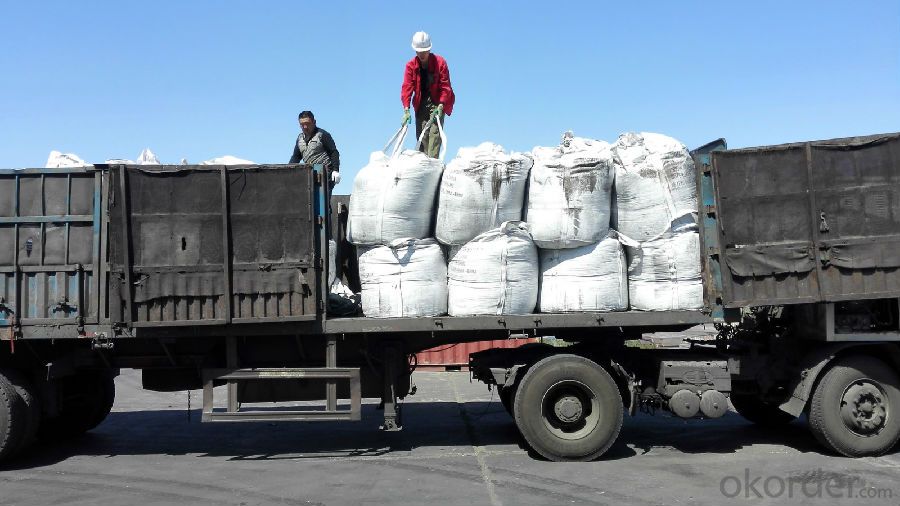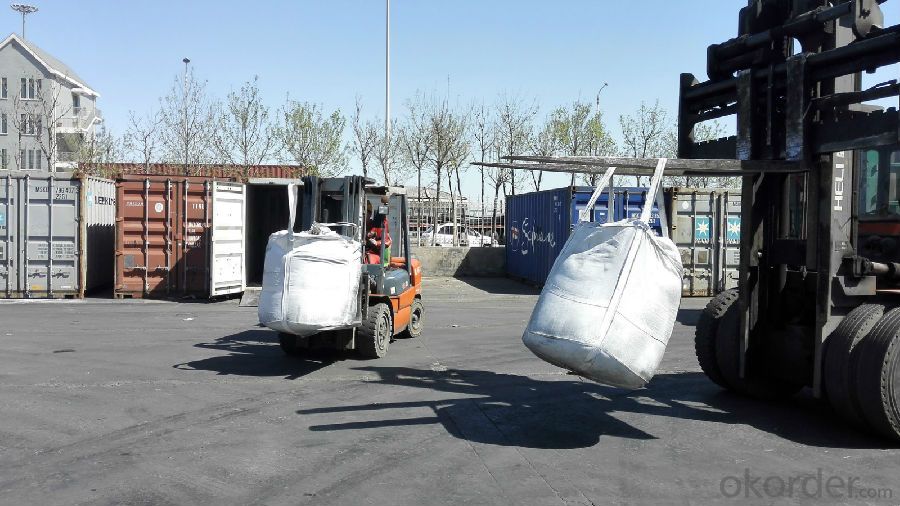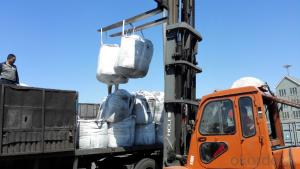FC88% Recarburizer with Ash 4% for steel making
- Loading Port:
- Tianjin
- Payment Terms:
- TT OR LC
- Min Order Qty:
- 20.1
- Supply Capability:
- 1001 m.t./month
OKorder Service Pledge
OKorder Financial Service
You Might Also Like
Introduction:
Calcined anthracite can be called carbon additive, carbon raiser, recarburizer, injection coke, charging coke, gas calcined anthracite.It is playing more and more important role in the industry
Best quality Anthracite as raw materials through high temperature calcined at over 2000℃ by the DC electric calciner with results in eliminating the moisture and volatile matter from Anthracite efficiently, improving the density and the electric conductivity and strengthening the mechanical strength and anti-oxidation. It has good characteristics with low ash, low resistivity, low sulphur, high carbon and high density. It is the best material for high quality carbon products. It is used as carbon additive in steel industry or fuel.
Features:
G-High Calcined Anthracite is produced when Anthracite is calcined under the temperature of 1240°C in vertical shaft furnaces. G-High Calcined Anthracite is mainly used in electric steel ovens, water filtering, rust removal in shipbuilding and production of carbon material.
Specifications:
F.C.% | 95MIN | 94MIN | 93MIN | 92MIN | 90MIN | 85MIN | 84MIN |
ASH % | 4MAX | 5MAX | 6 MAX | 6.5MAX | 8.5MAX | 12MAX | 13MAX |
V.M.% | 1 MAX | 1MAX | 1.0MAX | 1.5MAX | 1.5MAX | 3 MAX | 3 MAX |
SULFUR % | 0.3MAX | 0.3MAX | 0.3MAX | 0.35MAX | 0.35MAX | 0.5MAX | 0.5MAX |
MOISTURE % | 0.5MAX | 0.5MAX | 0.5MAX | 0.5MAX | 0.5MAX | 1MAX | 1MAX |
Pictures




FAQ:
Packing:
(1). Waterproof jumbo bags: 800kgs~1100kgs/ bag according to different grain sizes;
(2). Waterproof PP woven bags / Paper bags: 5kg / 7.5kg / 12.5kg / 20kg / 25kg / 30kg / 50kg small bags;
(3). Small bags into jumbo bags: waterproof PP woven bags / paper bags in 800kg ~1100kg jumbo bags.
Payment terms
20% down payment and 80% against copy of B/L.
Workable LC at sight,
- Q:How is carbon stored in the Earth's crust?
- Carbon is stored in the Earth's crust in various forms and geological processes. One primary way carbon is stored is through the formation of sedimentary rocks such as limestone, dolomite, and chalk. These rocks are primarily composed of calcium carbonate, which is derived from the shells and skeletons of marine organisms that lived millions of years ago. Over time, these remains accumulate on the ocean floor and are compacted and cemented to form sedimentary rocks, effectively trapping carbon within them. Another way carbon is stored in the Earth's crust is through the process of carbonation. Carbon dioxide (CO2) from the atmosphere can dissolve in water and react with certain minerals such as basalt, forming carbonate minerals like calcite or magnesite. This process occurs naturally through chemical weathering and volcanic activity, and it helps sequester carbon within the Earth's crust. Additionally, organic carbon is stored in the form of fossil fuels such as coal, oil, and natural gas. These fossil fuels are the remains of ancient plants and microorganisms that lived and died millions of years ago. Over time, the organic matter is buried and subjected to high pressure and temperature, undergoing a process called diagenesis, which eventually converts it into fossil fuels. These deposits act as reservoirs of carbon in the Earth's crust. Overall, the Earth's crust acts as a significant carbon sink, effectively storing carbon through various processes such as the formation of sedimentary rocks, carbonation, and the accumulation of fossil fuels. However, it is important to note that human activities, particularly the burning of fossil fuels, are releasing substantial amounts of stored carbon into the atmosphere, contributing to global climate change.
- Q:How does carbon affect the formation of tsunamis?
- Carbon does not directly affect the formation of tsunamis. Tsunamis are typically caused by underwater earthquakes, volcanic eruptions, or landslides, which are not influenced by carbon. However, carbon emissions and climate change can indirectly impact the frequency and intensity of natural disasters, including some potential triggers for tsunamis, such as volcanic activity or landslides near coastlines.
- Q:What are the effects of carbon emissions on the Arctic ecosystem?
- Carbon emissions have significant effects on the Arctic ecosystem. The increased levels of carbon dioxide in the atmosphere contribute to global warming, causing the Arctic to warm at a faster rate than the rest of the world. This leads to the melting of sea ice, loss of permafrost, and rising sea levels. These changes disrupt the delicate balance of the Arctic ecosystem, affecting various species, including polar bears, walruses, and seals, as well as their prey. Additionally, the acidification of the oceans due to carbon emissions further impacts marine life, such as plankton and shellfish. Overall, carbon emissions have detrimental consequences for the Arctic ecosystem, threatening its biodiversity and functioning.
- Q:What materials can be carbonitriding?
- Low temperature carbonitriding for high alloy tool steel, high-speed steel tools, etc., in temperature carbonitriding is under great pressure not only in carbon steel wear parts, high temperature carbonitriding is mainly used for medium carbon steel and alloy steel under great pressure.
- Q:What is electrical carbon?
- Different uses have different varieties, according to the use of electric carbon varieties can be divided into:(1) sliding contact carbon brushes and carbon sliders for all kinds of motor brushes.(2) various carbon and graphite contacts used in high power switches, relays, etc..(3) with various carbon arc lighting, carbon arc gouging, spectral analysis and arc furnace.(4) all kinds of high purity graphite electrodes, insulation and supporting elements for electric vacuum devices.(5) various electrodes used in dry cells and electrolytic cells.(6) the resistance effect of carbon. Made of various resistance, post, communication with the microphone carbon sand, resistance heating elements etc..
- Q:Learn photography for nearly half a year, has always wanted to buy a tripod, want to buy carbon fiber tripod, what brand is better? The machine is D700+24-70About 3000 is too expensive ~ consider 1000 more just fine. Wage earners!
- The three tripod has such a word: buy third tripod to know the first two are white bought!This sentence is a lot of friends with real money summed up, and hope to see!The three tripod is the most important, safe and reliable, and then the price, can not guarantee the safety of equipment, the price is cheaper and useless.The more than 1000 budget recommendations for the selection of source or berno, quality guaranteed, price is also good. If not on the cannon, not in harsh environment, the maximum diameter of 25mm, 4 section can also (cheap).Finally: carbon fiber hundreds of three tripod is not necessarily not, but never heard of this three foot will drop the camera, my answer can only represent personal views, for a reference.
- Q:Which carbon content is larger, steel or pig iron?
- carbon content more than 2.11% of iron, iron carbon content in general industry 2.5%--4%. I hope I can help you.
- Q:What is the role of carbon in the corrosion of metals?
- Carbon can play a significant role in the corrosion of metals by acting as a catalyst or an electrolyte. It can accelerate the corrosion process by promoting the formation of corrosive substances such as carbonic acid or carbon dioxide. Additionally, carbon can act as an electrolyte in certain environments, facilitating the flow of electrons and ions between the metal and the surrounding medium, thus enhancing corrosion.
- Q:What are the different types of carbon steel?
- Carbon steel, known for its strength, durability, and affordability, is widely utilized in various industries. It is a versatile material with multiple types, each possessing unique properties and applications. 1. Low Carbon Steel: This form of carbon steel contains a minimal amount of carbon, usually up to 0.25%. It is extensively used due to its affordability, ease of fabrication, and weldability. Low carbon steel finds applications in construction, automotive manufacturing, and general engineering. 2. Medium Carbon Steel: With a carbon content ranging from 0.25% to 0.60%, medium carbon steel offers increased strength and hardness compared to low carbon steel. It is commonly employed in machinery parts, axles, gears, and shafts that require enhanced toughness and wear resistance. 3. High Carbon Steel: High carbon steel contains a carbon content of 0.60% to 1.00%. It possesses excellent strength and hardness but is less ductile and more brittle than low and medium carbon steels. High carbon steel is frequently used in cutting tools, springs, and high-strength wires. 4. Ultra-High Carbon Steel: This type of carbon steel contains a carbon content exceeding 1.00%, typically ranging from 1.20% to 2.50%. It exhibits extremely high hardness and is often employed in specialized applications such as knives, blades, and tools that demand exceptional sharpness and wear resistance. 5. Carbon Tool Steel: Carbon tool steel refers to a group of steels that incorporate additional alloying elements like chromium, vanadium, or tungsten. These alloying elements enhance the steel's hardness, wear resistance, and heat resistance, making it suitable for tool and die making, cutting tools, and molds. It is important to note that the strength, hardness, and other properties of steel are determined by its carbon content. The selection of the appropriate type of carbon steel depends on the specific application, desired characteristics, and manufacturing requirements.
- Q:What is carbon neutral agriculture?
- Carbon neutral agriculture refers to farming practices that aim to balance out the amount of carbon dioxide released into the atmosphere with the amount removed or offset. It involves implementing sustainable techniques such as reducing greenhouse gas emissions, promoting carbon sequestration in soils, and utilizing renewable energy sources. The goal is to achieve a net-zero carbon footprint in agricultural activities, contributing to mitigating climate change impacts while ensuring food production and environmental sustainability.
1. Manufacturer Overview |
|
|---|---|
| Location | |
| Year Established | |
| Annual Output Value | |
| Main Markets | |
| Company Certifications | |
2. Manufacturer Certificates |
|
|---|---|
| a) Certification Name | |
| Range | |
| Reference | |
| Validity Period | |
3. Manufacturer Capability |
|
|---|---|
| a)Trade Capacity | |
| Nearest Port | |
| Export Percentage | |
| No.of Employees in Trade Department | |
| Language Spoken: | |
| b)Factory Information | |
| Factory Size: | |
| No. of Production Lines | |
| Contract Manufacturing | |
| Product Price Range | |
Send your message to us
FC88% Recarburizer with Ash 4% for steel making
- Loading Port:
- Tianjin
- Payment Terms:
- TT OR LC
- Min Order Qty:
- 20.1
- Supply Capability:
- 1001 m.t./month
OKorder Service Pledge
OKorder Financial Service
Similar products
New products
Hot products





























